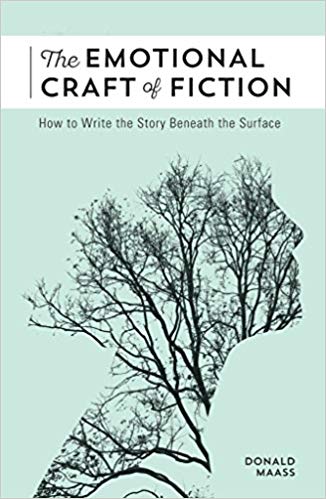Pinned 5 years 9 months ago onto Writing Guides

Whenever I go away I always take a writing guide with me to read. This month I took The Emotional Craft of Fiction: How to Write with Emotional Power, Develop Achingly Real Characters, Move Your Readers, and Create Riveting Moral Stakes by Donald Maass with me to England.
Normally when on a plane I jump up and want to get out of there as fast as possible, but I was so engrossed in this fantastic writing guide on my way over to England from my home in Spain, that I just sat there and wanted everyone to leave me alone...but then my husband bumped me along.
Even though I was on holiday visiting family, I just wanted to hide away in my hotel room and read all the lovely advice and immerse myself in all the inspiration and ideas that were falling in on me.
I stole every opportunity to keep reading and found this to be one of my most inspiring writing guides and highly valuable to authors who want to write stories that move their readers.
Reading Journey
Readers can simply read a novel...or they can experience it. The Emotional Craft of Fiction gives novelists inspiring ideas on how to create an emotional journey for their readers.
After my reviews from my latest novel, Flying Without Wings, showed that my readers were emotionally moved and touched by the story, I am more determined than ever to create an emotional journey for my readers of future novels.
In The Emotional Craft of Fiction, Veteran literary agent and expert fiction instructor Donald Maass shows you how to use story to provoke a visceral and emotional experience in readers.
Topics you will read and learn about include emotional modes of writing, beyond showing versus telling, your story's emotional world, moral stakes, connecting the inner and outer journeys, plot as emotional opportunities (take notes!), invoking higher emotions (some to the point of tears and no shame about that), symbols (highly inspiring) and emotional language.
He advocates that a novelist who wants to write strong fiction, must make their readers feel strongly and passionately. The reader's experience must be an emotional journey of its own. So much so, that it brings you the writer into the story and embeds you down with your characters' struggles, their discoveries, and their triumphs. If you are moved and touched by your own writing as you write the words of your story, so to will your readers be moved in the emotional reading journey you are sending them on.
I was thrilled to read this because I found myself in tears at a couple of points in Flying Without Wings as I was writing it.
Character Conflict
In The Emotional Craft of Fiction, Donald says it is vital that we as writers make our objective intentional. Make our conflict complex. Make our antagonist more determined, clever, powerful, righteous and resourceful than our protagonist. Make their inner struggle impossible to settle, thus making it altogether more difficult for them to get through the scene.
He, like most tutors on writing story structure, vouch that a goal, obstacles, antagonist and the hero’s inner conflict as the basic structure for each scene because when your POV character feels strongly and passionately, they react.
With the build up of tension and then its release of relief, that is the way to make a scene BIG.
Donald tells writers that we have an instinct for conflict. We see surprises hidden all around us. We watch people, not only to spot their character's habits and quirks, but to peer into their souls. We wonder how those people became the way they are now. We imagine scenarios of whom they could be and what could have happened to them. As worlds build in our heads, we must trust in our own instincts and find what is right in our stories.
When creating a fictional character, we should also use ‘I am’ to create uneasiness, and use ‘I am not’ to create doubt. That is powerful stuff, so much so that it is worth adding to your writing template or writing structure or whatever writing software you use to plot your novels.
Character Emotions
Create hope stronger than hope. The more readers will fear it will be fulfilled, and thus the greater the emotional relief when it works out okay.
One thing for sure, we must find a way to inject the spirit of compassion into our characters. Compassion is rooted in hope! We must find ways to manifest warmth that remains in a wounded heart.
Emotional Mastery
Throughout The Emotional Craft of Fiction each heading and sub-heading has emotional mastery attached. So, essentially, if you follow the mastery as lists, it effectively becomes a blueprint for your novel’s emotional plot.
Each ‘mastery’ lesson has several bullets for you to think about new ideas, consider alternative plot points and ways to add heart to your story. Many of these start with something like ‘take a scene’ or ‘go to a scene in your novel’ or ‘stop at a scene in your story’ and then Donald injects his suggestions for that topic’s mastery.
Donald arms you with a slow, rising resistance to change in your protagonist that builds to an explosive release by giving you several questions to ask yourself or to probe with your character.
Inspirational Writing Guide
My favourite writing guides have loads of sticky post-it notes sticking out the sides where I have marked to come back and re-read or add notes to my templates as The Emotional Craft of Fiction now has. In some places, I have marked exact phrases to add to my fictional characters’ template, so this fantastic and highly inspiring writing guide is an absolute must for novelists!
It feels like an author should read this book before each novel they write, just for inspiration alone. Learning is there of course, but I’ve had such inspiring ideas for my psychological thriller that I’m going to add lots of notes to my own personal writing template start point to remind me to go back and find the same inspiration again and again.


























